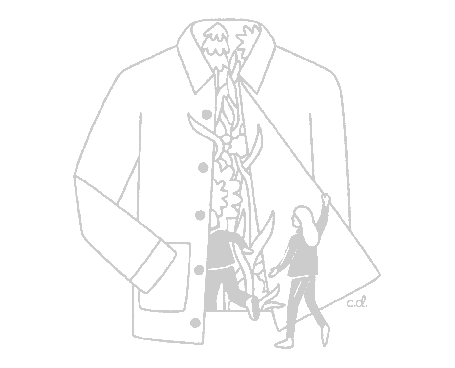Tracking the week by week progress of Batch No.3.5, our original chore jacket remade in Bill's Blue, in support of the NHS and to help our factory keep going safely during the Covid-19 pandemic.
Thanks to you, this jacket enabled us to send £10,000 of support to the British Red Cross Coronavirus campaign to help to pick up the pieces across the community.
...
Week 1.
The first thing we do when orders come in, is to download our order totals, and count up how many jackets we'll be making in each size. We both do the count and make sure the numbers come out the same.
Next up, it’s time to tell Sergio. He had already received the fabric from Berto, he’s just awaiting our news before the team can start cutting.
Your buttons are made in the UK by a small company called Courtney & Co. They’re made from Corozo nuts which have a lovely grainy texture, very much like wood, which you can see clearly once they’re dyed and the grain becomes more visible.
During week one, Andrea at Courtney & Co prepared and dyed the buttons. We ordered 2,000 in total, slightly more than we need but it's best to be safe.
The Corozo nut is grown on the Tagua Palm tree in Ecuador. They arrive in the UK in blank disc shapes ready to be carved into the right button shape. Your buttons are the classic Cornbury shape we’ve always loved.

Once every button is carved and ready, it’s time to dye them. Andrea starts by soaking the buttons in warm water, to open their pores. Meanwhile, she mixes the dye with some water and vinegar to act as a carrier. Once the dye is ready, it’s mixed with hot water (95-98 degrees), the buttons are added and we wait for the mixture to boil.
The buttons are constantly taken out and checked against our bill’s blue cutting, until they’re the right shade of blue. Once they’re happy, the buttons are rinsed in cold water. Next, they’re fixed to make sure they don’t lose colour.
Once they’re dry, they’re packed up and sent to the jacket factory in Portugal.
Weeks 2-3.
Meanwhile in Portugal, Lurdes (pictured below), Head of production has been talking to Sandra (Head of pattern cutting) to work out the schedule for the next few weeks. Between them they need to work out who will be working on our jackets, and in what order. At any one time, our factory is only working on 2 products. That’s because they’re a small and very specialised team.

As well as working out the team, they need to find out available slots at the dye house for shrink testing, and later, dying. They’re making sure that the timelines work nicely across the supply chain.
When the fabric arrived from Berto, every roll was sent to be shrink tested. That means it’s washed on high heat to simulate what a jacket goes through when it’s dyed. They’re checking to make sure the fabric shrinks by the exact % they’re are expecting, to make sure our sizing will be exactly as planned.
With results back and looking good, Sandra gets to work laying out the pattern on the computer, fitting each part of the jacket alongside others, making the very best use of every metre of fabric we have to minimise waste.
With the pattern pieces laid out efficiently, Sandra prints out a 1:1 scaled sheet, simulating how we'll cut out every piece. Then, fabric is laid out on the cutting table, stacked up so we can neatly cut multiple pieces using the razor sharp electronic cutting knife.
Pattern paper is laid on top for guidance, and cutting begins. All off-cuts from the cutting process will be recycled into new cotton thread in Portugal.
With every size cut, the team assemble every piece needed for one jacket, bundling up each and every piece ready for the next stage: sewing.

...
Week 4.
Preparations for the sewing stages begin at this point. Pockets and collars are prepared first.
Every pocket needs to be prepared one by one. The edges are overlocked so you won’t feel any loose threads when you put your hand into your pocket. Then they’re neatly folded and pressed.
With preparations done, it's time for sewing to begin. Each jacket makes it's way down the production line. Slowly but surely and with great precision, it all starts to come together.


At every stage throughout the making process, your jacket is being checked by Sergio and his team. To put it simply, they're ruthless at every stage. If there are any details less than perfect, they don't cut corners, they start all over again.
Week 5.
Next, your jacket heads 20km up the road to neighbouring district, to Vizela, to the dye house.
Each jacket takes 7 hours to be dyed. They'll begin with nice long soak to make sure colour takes evenly, then the dye is mixed with water and added into the drum. For a few hours, they'll spin one way, then the other way, making sure colour coverage is perfect. And then it's time to dry.

Once they're dry, they'll head back to the factory for buttons to be sewn on.
Week 6
Each button is sewn on by machine and then checked by hand.
We've also introduced a new button securing system to make sure the threads are extra strong.

Finally, each jacket is quality checked inside and out. Then they're folded, organised into boxes with other jackets their size, and packed up onto a palette ready to begin their journey to us.
They journey is by road and takes another 7 days. It's not the quickest, but it's a lot better for the planet than by flight.

Once they arrive, we check, hand-number each one and pack it up to head to you.
Thank you for supporting Batch No.3.5, our smallest batch yet, but the one with the biggest impact.

